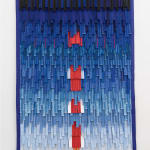 Bleu, rouge, orange et blanc
Bleu, rouge, orange et blanc
 Bleu, rouge, orange et blanc
Bleu, rouge, orange et blanc
 Bleu, rouge, orange et blanc
Bleu, rouge, orange et blanc
Abdoulaye Konaté
107 87/100 x 74 4/5 in
Further images
Mali’s rich and culturally diverse society has heavily influenced the work of Bamako-based artist Abdoulaye Konaté (1953). Konaté’s introduction to the arts was at the Institut National des Arts in Bamako, where he studied painting, and then further, at the Instituto Superior des Arte in Havana, Cuba where he was strongly influenced by his teacher Wilfred Lam. Upon returning to Mali in 1985, Konaté made the transition from working in paint to textiles, coining his own unique visual language, combining patches and swaths of dyed cloth just as a painter uses oils, to create large, radiantly coloured textile works. For decades, the Malian artist who is of the most influential voices of African art has been tackling subjects such as war, power, religion, globalization, ecological shifts and the AIDS epidemic within the continent's societies.
Konaté’s large-scale compositions are created using local Malian fabrics. Traditionally woven and dyed by women, these colourful cloths play an important role in the identity politics of the region and the diaspora. Konaté’s works breathe fresh life into West Africa’s rich and dynamic textile traditions. In this intensive exploration of the spectrum of blue tones, he pays tribute to the indigo dye that has been so central to West African aesthetics. Konaté dives into contemporary dialogue, with a firm grip on his local culture thereby honoring the traditional usage of these fabrics as a ceremonial and narrative tool.
Konaté’s insatiable exploration of color tones has resulted in a beautiful body of works. In an interview in 2015, the artist said: “For me, working with colours is like a world of its own where you perceive a variety of colours to the point where it becomes almost like alchemy. The range of blues gives me all the depth that I need. I worked with a range of blues, the same ways as if I was working on a painting. I do compose my own colours. It has to be exactly the right colour for me. If not, I change it until its fits. I researched all the possibilities, all the declinations of the colour range. When I started looking into the range of blues, I analysed what people wear in Mali, starting from the blue garments of the Tuareg in the North of Mail to the white attire that the Arabs in Mali wear. In between there is a blue that reminds you of the colour of water that you can find with the fishermen who work on the Niger River. So for me, it is not only an empirical analysis, but also an analysis of the realities, of what people really do wear. It gives me another kind of richness that allows me to share that colour choice with different people on an educational level, on an aesthetic level, so that ethnic groups also accept other types, other ranges of colour. “
Part abstract, part figurative, Konaté’s compositions bring us in a universe filled with layers of symbolism. Conversations take place between the textiles and the viewer, based on the inherent meanings of the fabrics. Even if the political activism of earlier works is cast aside, Konaté’s language is unchanged, always strong, substantial, forged to speak of mankind through a pure medium such as colour. Konaté’s textile works have a special painterly quality and alternate between the surface-oriented and the rendering of spatial depth. Konaté’s majestic works are powerful and breathtaking.
Abdoulaye Konaté (b. 1953) is the founding Director of the Conservatoire des Arts et Métiers Multimédia Balla Fasséké Kouyaté in Bamako, Konaté is dedicated to the education of younger generations. The artist exhibited at prominent locations around the world such as the Centre Georges Pompidou in Paris and the Royal Academy of Arts in London. He received several prominent awards and accolades, including the prestigious Léopold Sédar Senghor Prize at the Dak’Art Biennale in Dakar (1996). Major group shows include Africa Remix, whose international tour visited the Centre Pompidou, Paris and Hayward Gallery, London (2004-2007) and Documenta 12 (2007), Kassel, SCAD Museum of Art, Savannah Georgia (2014-2015) and the National Museum of African Art, Smithsonian Institute, Washington D.C. (2015). In 2016 he had a solo exhibition at the Arken Musem of Copenhagen, and in 2017, Konaté was selected to participate in Viva Arte Viva, the central exhibition of the 57th Venice Biennale.
let's keep in touch
Join our community & never miss out on a DUENDE moment from now on
* denotes required fields
We will process the personal data you have supplied to communicate with you in accordance with our Privacy Policy. You can unsubscribe or change your preferences at any time by clicking the link in our emails.


